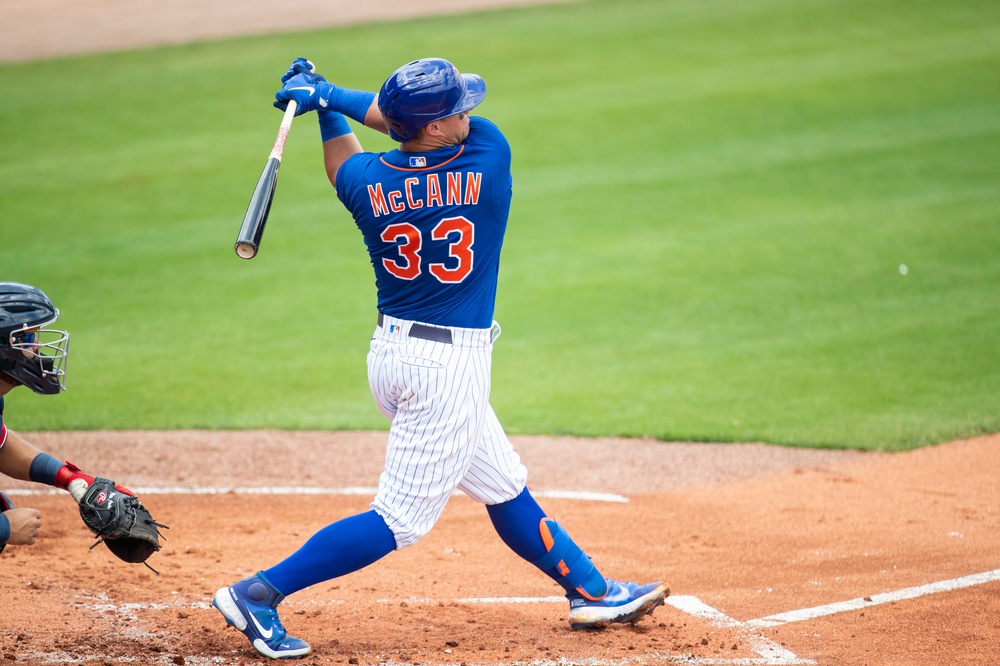
Mandatory Credit: Mary Holt-USA TODAY Sports
Heading into this past offseason, many of us were clamoring for the New York Mets to sign free-agent catcher J.T. Realmuto (myself included in that bunch). The organization ended up signing James McCann instead, which has already led to a number of happy occurrences.
For instance, if the Mets committed $100-plus million to Realmuto, it would’ve been less likely for New York to go ahead and acquire Carlos Carrasco and Francisco Lindor (along with currently negotiating extensions for Lindor and Michael Conforto). Committing $40.6 million to McCann over the next four years provides plenty of financial flexibility for the club moving forward. They’ll also be getting a huge upgrade defensively behind the plate, but what about his offense?
Between 2014 and 2018 with the Detroit Tigers, McCann slashed .240/.288/.366 through 1,658 plate appearances, which led to a lackluster 75 wRC+ and a cumulative fWAR of -0.2. But with the Chicago White Sox the past two seasons, he’s turned things around, but accumulating 3.7 fWAR over 587 plate appearances, including a much healthier .276/.334/.474 line and a 115 wRC+.
With McCann’s strong defensive reputation behind the plate and the progress he’s made on offense, he could be a valuable asset. Knowing the type of breakout he’s experienced during the past two seasons in Chicago, it initially surprised me to see how pessimistic his offensive projections are looking for 2021. FanGraphs’ Steamer projections are tabbing him for 15 home runs and 52 RBI in 427 plate appearances, but it’s accompanied with a .229/.290/.387 triple slash and an 80 wRC+.
Sure, there still may not be enough data from his better offensive years to completely wipe out what the 30-year-old had done prior to that, but this urged me to dig into exactly why these projections look so different from what he’s accomplished recently.
No True Full-Season Breakout Yet
McCann was on another level during the first half of 2019. The backstop’s first 251 plate appearances led to a .316/.371/.502 line with nine homers, 30 RBI, and a 132 wRC+. His performance was so good that he earned his first career All-Star Game appearance. Once the midsummer classic was over, McCann cooled off for the remainder of the year. In his final 225 plate appearances, his triple slash took a dive to .226/.281/.413, while his wRC+ went all the way down to 82.
It was encouraging to see his power essentially stay the same — his ISO actually increased slightly from .186 to .188 — but he wasn’t at all close to the All-Star player he was in the first half.
When we switch gears and look at his cumulative 2020 performance, we see improvements (albeit in just 111 plate appearances). McCann’s OPS jumped more than 100 points to .896 and his wRC+ continued climbing up to 143. Even in a 60-game regular season, there was a noticeable split in his first- and second-half production. Advanced statistics had it all being more than serviceable (160 first-half wRC+ and 128 second-half wRC+). However, a lot of his production was dependent on a huge rise in ISO (.191 to .300) thanks to more than doubling his extra-base hits down the stretch (three homers in the first half, four homers and three doubles in the second half).
There was an interesting similarity between 2019 and 2020 upon taking a longer peek at McCann’s FanGraphs page, though.
The Rise (and Fall) in BABIP
By looking at McCann’s year-by-year numbers, there’s one thing in particular that jumps off the page as he transitioned from Detroit to Chicago (photo via FanGraphs):

Can you see it? Yea, me too. When using years in which he accumulated at least 100 plate appearances, the last two seasons have included his two best single-season BABIPs, and the difference between his Tigers and White Sox tenures is stark. After posting a .298 BABIP through his first 1,658 plate appearances, that number has gone all the way up to .355 over his most recent 587 trips to the plate.
When that number is broken down to the first half and second half in each year, the same trend emerges for this situation. In 2019, McCann entered the All-Star break with a .408 BABIP. During the second portion of the year, it dropped all the way down to .299. His first-half BABIP in 2020 was nearly identical to the year before (.406), although his second-half BABIP was worse than the year prior (.267).
Interestingly enough, the veteran catcher’s hard-hit rate increased between the first and second half of each campaign. Check it out:

There were some other changes within his batted-ball profile that likely led to a decrease in production (a spike in infield-fly rate in 2019 and a sizable drop in line drives plus a huge increase in fly balls during 2020). But still, if someone took a look at the above quality of contact comparisons, it’d be easy to assume things like BABIP and overall production increased throughout the year, not the other way around.
So, The Projections Make Sense
While I was surprised to see McCann’s 2021 offensive projections be so low, it kind of makes sense. He’s made some clear progress in his execution at the plate, and after experiencing that drop following the 2019 All-Star break, the shortened season of 2020 didn’t allow him to show he’s capable of elevated production for a prolonged period of time.
It’ll be interesting to see how he’s able to adjust offensively to a new division and new league after being in the American League Central for the duration of his MLB career to this point. Projections should always be taken with a grain of salt, and this is just the latest case because they’re based on what happened in the past. Either way, 2021 is an opportunity for McCann to show he can sustain above-average levels of offense for the duration of a 162-game campaign, providing the type of value on offense and defense the Mets are hoping to get out of him.
















